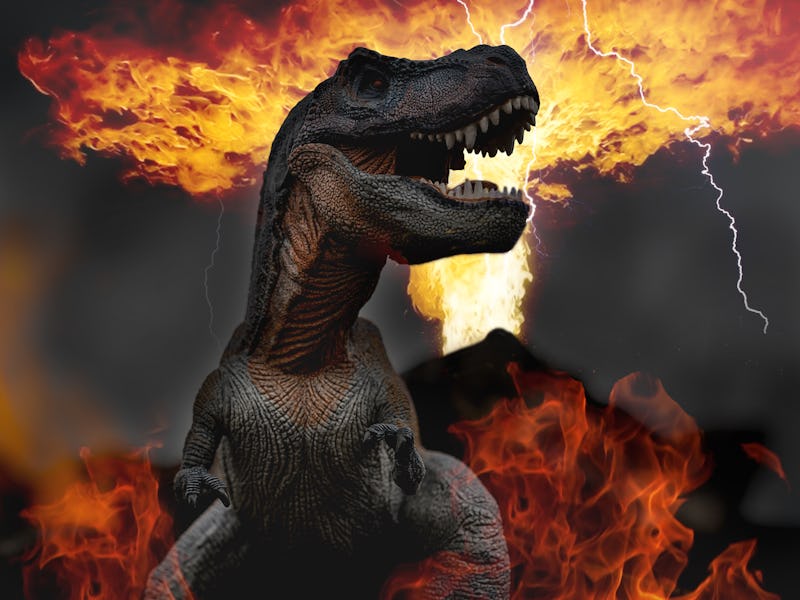Dinosaurs literally walked on fire — study
Fossilized footprints reveal dinosaurs thrived in the Karoo Basin, a region in South Africa — despite the fact that it was full of lava.

From what we know about early Earth, dinosaurs put up with some wild circumstances — toxic plants, underwater magma, and that's before the asteroid that ultimately wiped them out. And to thrive in these intense conditions, they evolved some nifty skills — like the ability to walk on fire.
A few dozen fossilized footprints reveal that a group of dinosaurs were still kicking when the Karoo Basin, a region in South Africa, began to fill up with lava some 183 million years ago. The study, led by University of Cape Town geology professor Emese Bordy, was published Wednesday in the journal PLOS ONE.
Before now, researchers had no idea that dinosaurs and therapsids, the creatures from which mammals evolved, had managed to survive the moment when lava began to flood their habitat, turning it into a “land of fire.”
"The fossil tracks tell a story from our deep past on how continental ecosystems could co-exist with truly giant volcanic events that can only be studied from the geological record,” Bordy said in a statement.
The paper’s authors call the flow “one of the most dramatic geological episodes in southern Africa.”
Trackways at the Highlands ichnosite.
The discovery came when researchers unearthed 25 dinosaur footprints in a layer of sandstone, sandwiched between lava flows. The prints make up five trackways, and probably belonged to three types of animals:
- Synapsids: The ancestors of mammals, a group that includes the fin-backed Dimetrodon.
- Bipedal dinosaurs: Likely carnivorous, similar to T.Rex.
- Quadrupedal dinosaurs: Small, likely herbivorous, similar to stegosaurus.
In an extra boon, the footprints revealed a new kind of ichnospecies — a kind of fossil mystery puzzle. Ichnofossils are also known as trace fossils — and ichnospecies of plants and animals are only known to science because of those small traces of their existence, even though no actual fossil remains have been found.
Perhaps unsurprisingly, given its geologically chaotic history, the Karoo Basin is a popular spot for studying ancient lava floes — not for fossil remains. But lava contains sandstone “interbeds” which can occasionally yield fossils like these ones that provide clues to the animals that once called the area home.
Further research may uncover even more fossils in the Basin, allowing scientists to zoom in on exactly when the cascading lava formed different layers of rock. Scientists may also glean information about how the flora and fauna in the Karoo Basin reacted to major events, like, you know, being completely covered with lava.
Ultimately, the findings could also hold clues to life on a future Earth, the scientists say. While these kinds of catastrophic events don’t have a modern equivalent we need to worry about right now, “they can occur in the future of the Earth," Brody said.
Abstract: The Karoo igneous rocks represent one of the largest continental flood basalt events (by volume) on Earth, and are not normally associated with fossils remains. However, these Pliensbachian–Toarcian lava flows contain sandstone interbeds that are particularly common in the lower part of the volcanic succession and are occasionally fossiliferous. On a sandstone interbed in the northern main Karoo Basin, we discovered twenty-five tridactyl and tetradactyl vertebrate tracks comprising five trackways. The tracks are preserved among desiccation cracks and low-amplitude, asymmetrical ripple marks, implying deposition in low energy, shallow, ephemeral water currents. Based on footprint lengths of 2–14 cm and trackway patterns, the trackmakers were both bipedal and quadrupedal animals of assorted sizes with walking and running gaits. We describe the larger tridactyl tracks as “grallatorid” and attribute them to bipedal theropod dinosaurs, like Coelophysis, a genus common in the Early Jurassic of southern Africa. The smallest tracks are tentatively interpreted as Brasilichnium-like tracks, which are linked to synapsid trackmakers, a common attribution of similar tracks from the Lower to Middle Jurassic record of southern and southwestern Gondwana. The trackway of an intermediate-sized quadruped reveals strong similarities in morphometric parameters to a post-Karoo Zimbabwean trackway from Chewore. These trackways are classified here as a new ichnogenus attributable to small ornithischian dinosaurs as yet without a body fossil record in southern Africa. These tracks not only suggest that dinosaurs and therapsids survived the onset of the Drakensberg volcanism, but also that theropods, ornithischians and synapsids were among the last vertebrates that inhabited the main Karoo Basin some 183 Ma ago. Although these vertebrates survived the first Karoo volcanic eruptions, their rapidly dwindling habitat was turned into a land of fire as it was covered by the outpouring lavas during one of the most dramatic geological episodes in southern Africa.